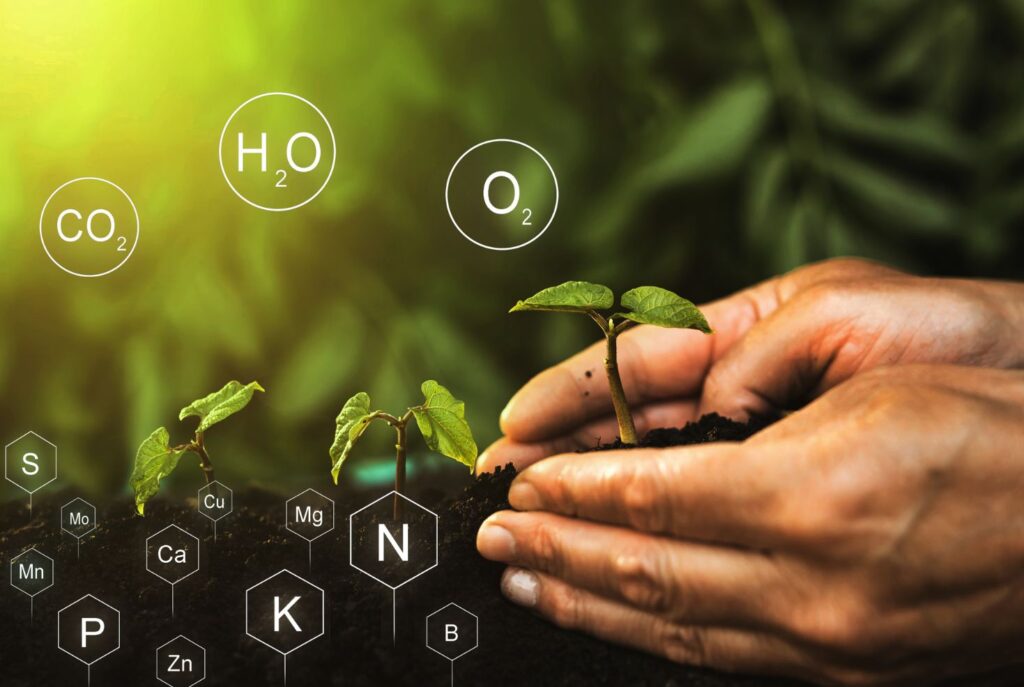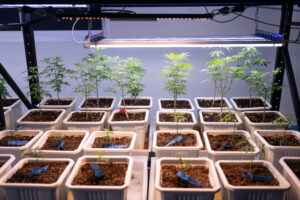
Welcome to a comprehensive exploration of plant nutrition, where understanding the balance of nutrients is key to achieving optimal plant growth and health. In this guide, we’ll delve into the crucial roles of both macronutrients and micronutrients, highlighting their unique contributions to a plant’s lifecycle and overall well-being.
Macronutrients are required in larger quantities and serve as the primary building blocks of plant health. They influence major functions such as growth, development, and productivity by providing essential elements that act as energy sources and structural components.
Micronutrients, needed in smaller amounts, are equally vital. They act as catalysts in numerous biochemical processes, helping plants complete their life cycle, defend against pests, and adapt to environmental stresses.
We’ll explore how both deficiencies and excesses of these nutrients can impact plant health, providing guidance on how to identify and address imbalances. This guide is aimed at everyone from experienced gardeners to casual plant enthusiasts, offering insights that will help you cultivate robust and resilient plants.
Table of Contents

Understanding Plant Nutrients
The foundation of plant health and productivity lies in the soil, specifically in the nutrients that soil provides. Just as humans need a balanced diet to function at their best, plants require a mix of essential nutrients to grow, thrive, and reproduce. Understanding these plant nutrients, their roles, and how they affect plant growth is critical for anyone involved in gardening, farming, or botany. In this section, we’ll explore what plant nutrients are, categorize them into macronutrients and micronutrients, and explain their importance in the plant lifecycle.
What Are Plant Nutrients?
Plant nutrients are elements from the soil that plants absorb through their roots to sustain growth, development, and reproduction. These elements are indispensable; without them, plants cannot complete their lifecycle. They contribute to various physiological and biochemical processes, from structural formation to energy production and defense mechanisms against pests and diseases.
Categories of Plant Nutrients
Plant nutrients are broadly classified into two categories based on the quantities that plants need: macronutrients and micronutrients.
- Macronutrients: These are required by plants in larger amounts. They include both primary nutrients (nitrogen, phosphorus, potassium) and secondary nutrients (calcium, magnesium, sulfur). Macronutrients are integral to basic cellular functions, energy production, and the synthesis of organic molecules.
- Micronutrients: Though needed in much smaller quantities, micronutrients are equally vital to plant health. They include elements like iron, manganese, copper, zinc, boron, molybdenum, and chlorine. Micronutrients often act as cofactors for enzymes, playing crucial roles in metabolic processes and disease resistance.
Importance of Plant Nutrients
The role of each nutrient in plant health cannot be overstated. From the macro to the micronutrient level, each plays a unique role:
- Structural Support: Macronutrients like nitrogen, phosphorus, and potassium contribute to the physical structure of the plant, supporting everything from the development of robust root systems to the strength and integrity of stems and leaves.
- Energy Production and Metabolism: Phosphorus is part of ATP, the energy currency of cells, while magnesium is central to chlorophyll and essential for photosynthesis.
- Disease Resistance and Stress Tolerance: Potassium, for example, helps in water regulation and disease resistance, while micronutrients like copper and zinc play roles in plant immunity and stress response.
Understanding these nutrients and their functions allows for better management of soil and plant health, leading to more robust plant growth, higher yields, and healthier ecosystems. Whether you’re adjusting soil pH, applying fertilizers, or choosing plants for specific soil types, a foundational knowledge of plant nutrients and their roles is indispensable.

The Crucial Macronutrients
Plants rely on a suite of essential nutrients to sustain their growth, health, and reproductive success. Among these, macronutrients stand out due to their significant demand within the plant’s lifecycle. These nutrients can be categorized into primary and secondary macronutrients, each playing unique roles in plant development and physiology. Here, we delve into the crucial macronutrients that every plant needs to thrive.
Primary Macronutrients
The primary macronutrients are nitrogen, phosphorus, and potassium. They are called primary because they are required in larger quantities than other nutrients and are crucial for basic cellular functions and overall plant growth.
1. Nitrogen (N)
- Role in Plant Health: Nitrogen is essential for the synthesis of amino acids, the building blocks of proteins. It’s heavily involved in the creation of chlorophyll, the molecule that gives plants their green color and facilitates photosynthesis.
- Impact on Growth: A sufficient supply of nitrogen promotes healthy leaf and vegetative growth, making it vital for the early stages of plant development.
- Deficiency Symptoms: Yellowing of leaves (chlorosis) starting with older leaves, stunted growth, and poor yield are common signs of nitrogen deficiency.
2. Phosphorus (P)
- Role in Plant Health: Phosphorus plays a critical role in the formation of DNA and RNA, the genetic materials of plants. It’s involved in ATP (adenosine triphosphate), which is crucial for energy transfer within the plant.
- Impact on Growth: Phosphorus is essential for root development, flowering, and seed production, impacting the plant’s reproductive success.
- Deficiency Symptoms: Dark green foliage with purplish discoloration, stunted growth, and delayed flowering are indicators of phosphorus deficiency.
3. Potassium (K)
- Role in Plant Health: Potassium is important for enzyme activation, osmotic balance, and photosynthesis. It enhances the plant’s ability to resist disease and improves the quality and quantity of fruits and flowers.
- Impact on Growth: Adequate potassium improves plant vigor and resistance to environmental stresses, such as drought and cold.
- Deficiency Symptoms: Yellowing and browning of leaf edges, weak stems, and reduced resistance to diseases are signs of potassium deficiency.
Secondary Macronutrients
Secondary macronutrients include calcium, magnesium, and sulfur, which are required in lesser amounts than the primary nutrients but are still vital for plant health.
1. Calcium (Ca)
- Role in Plant Health: Calcium is integral to the cell wall structure, promoting strong cellular integrity and development. It is also crucial for enzyme activity and signal transduction in plants.
- Impact on Growth: Influences root and leaf development, affecting overall plant structure and stability.
- Deficiency Symptoms: New leaves may appear distorted or irregularly shaped, and root growth can be stunted.
2. Magnesium (Mg)
- Role in Plant Health: Magnesium is a central component of chlorophyll and is necessary for photosynthesis. It plays a role in enzyme activation and plant metabolism.
- Impact on Growth: Crucial for energy production and the synthesis of DNA and RNA.
- Deficiency Symptoms: Interveinal chlorosis (yellowing between the leaf veins) and leaf curling.
3. Sulfur (S)
- Role in Plant Health: Sulfur is a key player in the formation of proteins, enzymes, and vitamins. It is also essential for the production of certain aromatic compounds and oils in plants.
- Impact on Growth: Helps with the plant’s resistance to disease and overall vigor.
- Deficiency Symptoms: Younger leaves turn yellow first, and growth may be stunted.
Understanding the roles and managing the balance of these macronutrients is essential for achieving optimal plant growth and health. Gardeners, farmers, and plant enthusiasts should ensure their plants receive a balanced diet that meets all their nutritional needs.

The Essential Micronutrients
Micronutrients, despite being required by plants in much smaller quantities than macronutrients, play an indispensable role in their overall health and development. Each of these nutrients supports specific functions that are critical to the plant’s ability to grow, reproduce, and fend off diseases. Let’s explore the essential micronutrients and their significant roles in plant life.
1. Iron (Fe)
Iron is crucial for the synthesis of chlorophyll, the green pigment responsible for photosynthesis. It also acts as an electron carrier in the production of energy, facilitating various biochemical processes within the plant. A deficiency in iron leads to chlorosis, a condition where leaves turn yellow due to inadequate chlorophyll production, severely affecting the plant’s ability to synthesize food.
2. Boron (B)
Boron plays a vital role in cell wall formation and repair, ensuring structural integrity and proper cell function. It is also essential for pollen germination and seed production, impacting the reproductive success of plants. Boron deficiency can lead to brittle, discolored leaves, and poor fruit or seed development.
3. Manganese (Mn)
Manganese acts as a cofactor for various enzymes, crucial for chlorophyll production and thus, photosynthesis. It also aids in nitrogen assimilation and resistance to root pathogens. Signs of manganese deficiency include interveinal chlorosis and brown spots on leaves, which can compromise plant health and yield.
4. Copper (Cu)
Copper is involved in several plant processes, including photosynthesis, respiration, and the linking of proteins to DNA. It plays a role in lignin synthesis, which is necessary for cell wall strength and stem stability. Copper deficiency often manifests as stunted growth and pale, limp leaves.
5. Zinc (Zn)
Zinc is essential for hormone regulation and stem growth. It influences the synthesis of auxin, a key growth hormone, and is critical for enzyme systems that regulate growth rates. Deficiencies in zinc can lead to stunted growth, leaf discoloration, and irregular leaf formation.
6. Molybdenum (Mo)
Molybdenum is necessary for nitrogen fixation in legumes and the reduction of nitrates within the plant, which are vital processes for protein synthesis. Without sufficient molybdenum, plants may exhibit nitrogen deficiency symptoms, such as poor growth and pale leaves.
7. Chlorine (Cl)
Though required in very small amounts, chlorine is important for osmosis and ionic balance within the plant. It is also involved in photosynthesis, specifically in the splitting of water to release oxygen. Chlorine deficiency is rare but can cause wilting and reduced growth.
Understanding the roles and signs of deficiency in these micronutrients is crucial for diagnosing and addressing plant health issues. Ensuring that plants have access to a balanced diet of both macro and micronutrients can significantly impact their growth, productivity, and resilience.

Balancing Plant Nutrition
Balancing the nutrition of plants is akin to walking a tightrope: too little or too much of any nutrient can tip the balance and negatively impact plant health. Understanding the nuanced differences in the quantity needed between macro and micronutrients, as well as their distinct roles, is essential for maintaining this balance and ensuring optimal plant growth. Let’s explore the delicate dance of plant nutrition, highlighting the importance of both types of nutrients and the consequences of imbalances.
Difference in Quantity Needed
- Macronutrients: These are required in larger amounts as they form the foundation of plant growth. They include nitrogen (N), phosphorus (P), potassium (K), calcium (Ca), magnesium (Mg), and sulfur (S), each serving critical roles in the plant’s cellular functions and structural integrity.
- Micronutrients: These are required in smaller quantities, but they are nonetheless crucial for the plant’s health and development. Elements like iron (Fe), boron (B), copper (Cu), manganese (Mn), zinc (Zn), molybdenum (Mo), and chlorine (Cl) support various functions, from enzyme activity to disease resistance.
Importance of Macronutrients
Macronutrients serve as the primary building blocks for plant cells, playing a pivotal role in:
- Structural Components: Forming vital parts of cellular structures, like chlorophyll and amino acids, which are essential for photosynthesis and protein synthesis.
- Energy Production: Facilitating the creation of ATP (adenosine triphosphate), the energy currency within plants, crucial for their growth and metabolism.
- Overall Growth and Health: Supporting processes like osmotic balance, enzyme activation, and disease resistance, directly influencing the plant’s vitality and productivity.
Importance of Micronutrients
Though needed in trace amounts, micronutrients are vital for:
- Enzyme Function: Acting as cofactors for enzymes, enabling a plethora of biochemical reactions essential for the plant’s metabolic processes.
- Disease Resistance: Some micronutrients, like copper, play a role in enhancing the plant’s ability to resist certain pathogens and diseases.
- Synthesis of Plant Compounds: Involved in the synthesis of crucial organic molecules, such as the role of molybdenum in nitrogen utilization, which is vital for the plant’s ability to synthesize amino acids and proteins.
Consequences of Nutrient Deficiencies and Toxicities
Both deficiencies and excesses in these nutrients can lead to visible symptoms and impact plant health:
- Deficiencies: These can result in symptoms like chlorosis (leaf yellowing), necrosis (death of tissue), stunted growth, and reduced yield, each specific to the lacking nutrient.
- Toxicities: Excessive nutrient levels can cause toxicity symptoms, including leaf burn, inhibited growth, and even plant death in severe cases.
Proper diagnosis and understanding of nutritional imbalances in plants are crucial for correcting these issues and ensuring optimal growth. This process involves soil testing to determine the availability of essential nutrients, thoughtful fertilization practices tailored to the specific needs of the plants, and sometimes the application of targeted nutrient supplements to address deficiencies or mitigate toxicities.
Balancing plant nutrition requires a deep understanding of the nuanced roles of each nutrient. Careful observation of plant health, coupled with responsive management practices, is essential for maintaining this balance. Achieving proper nutrient balance is critical for developing healthy, robust plants that can reach their full genetic potential in both growth and productivity. This comprehensive approach helps create a thriving environment where plants can flourish and produce high-quality yields.

Achieving Optimal Plant Growth
Ensuring that plants receive the right balance of nutrients is fundamental to their growth, health, and productivity. Achieving optimal plant growth involves more than just providing water and sunlight; it requires a keen understanding of the nutritional needs of your plants and the ability to adjust those needs as they grow and develop. Here are some guidelines to help you ensure your plants are getting the balanced diet of macronutrients and micronutrients they need to thrive.
1. Conduct Soil Testing
- Why It’s Important: Soil testing provides crucial information about the nutrient composition of your soil, including pH levels and concentrations of key nutrients.
- How to Use This Information: Use the results to tailor your fertilization strategy, ensuring your plants receive the right nutrients in the correct amounts.
2. Understand Plant-Specific Nutrient Needs
- Tailor Nutrient Application: Different plants have varying nutrient requirements at different stages of their lifecycle. Understanding these specific needs allows you to provide the right nutrients at the right time.
- Adjust Fertilization Accordingly: For example, leafy greens may require more nitrogen for leaf development, while flowering plants might benefit from higher phosphorus levels to encourage blooms.
3. Use a Balanced Fertilizer
- Choosing the Right Fertilizer: Select a fertilizer that provides a balanced blend of both macronutrients and micronutrients. This helps prevent nutrient imbalances that can lead to poor plant health.
- Application Tips: Follow the manufacturer’s instructions carefully to avoid over-fertilization, which can harm plants and disrupt soil nutrient balance.
4. Monitor Plant Health and Soil Conditions Regularly
- Observation is Key: Regularly inspect your plants for signs of nutrient deficiencies or toxicities. Symptoms like yellowing leaves, stunted growth, or poor flowering can indicate nutritional problems.
- Adjust Nutrient Levels as Needed: Based on your observations and any soil test results, adjust your fertilization practices to address any deficiencies or imbalances.
5. Incorporate Organic Matter
- Benefits of Organic Matter: Adding compost or other organic matter to your soil can improve its structure, water retention, and nutrient content.
- Long-Term Nutrient Management: Organic matter slowly releases nutrients into the soil, providing a steady supply that supports plant health over time.
6. Practice Crop Rotation and Diversity
- Avoid Nutrient Depletion: Rotating crops and growing a diverse range of plants can help prevent soil nutrient depletion and reduce the risk of disease.
- Promote Soil Health: Different plants contribute to and take from the soil differently, promoting a balanced nutrient environment.
By following these guidelines and paying close attention to the needs of your plants, you can achieve optimal plant growth, ensuring your garden or farm is both healthy and productive.
Conclusion
Understanding the essential roles of macronutrients and micronutrients is crucial for successful plant cultivation. Macronutrients provide the structural support needed for growth, while micronutrients facilitate vital biochemical processes. Each nutrient plays a unique role in the complex system of plant development, making balance critical.
Identifying and correcting nutrient imbalances ensures that plants not only survive but thrive. This guide aims to deepen your plant nutrition knowledge, applicable to small gardens and large-scale agriculture. The blend of art and science in meeting plants’ nutritional needs, whether through soil amendments, organic matter, or fertilizers, is fundamental to cultivating healthy, productive plants.
We hope this exploration has provided valuable insights and inspired you to care for your plants with a renewed perspective. Applying these principles helps nurture nature’s bounty. For a more detailed understanding of diagnosing and addressing specific nutrient issues, check out our comprehensive guide on Cannabis Plant Deficiencies. May your gardening endeavors lead to lush, healthy plants and abundant harvests. Happy gardening!
Additional Resources:
Grow That Sh!t Better by Maximus Reigns – An essential eBook for both novice and experienced growers, offering advanced techniques and tips for improving cannabis cultivation.
Cannabis Growers’ Handbook by Ed Rosenthal – A comprehensive guide that covers all aspects of growing cannabis, from setup to harvest.
Royal Queen Seeds Blog – A rich resource for growers, featuring articles on growing techniques, strain information, and more.
Need Cannabis Seeds? – Seedsman Seeds has a variety of seeds for all growers from new and seasoned to medical and CBD users.
Grow Weed Easy – A website dedicated to providing step-by-step guides and resources for growing cannabis at home.









